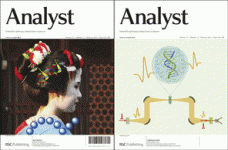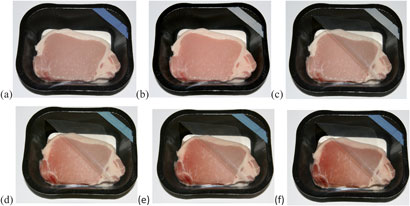
Minireview
Single-stranded DNA (ssDNA) production in DNA aptamer generation, Citartan Marimuthu, Thean-Hock Tang, Junji Tominaga, Soo-Choon Tan and Subash C. B. Gopinath, Analyst, 2012, 137, 1307-1315

Minireview
Single-stranded DNA (ssDNA) production in DNA aptamer generation, Citartan Marimuthu, Thean-Hock Tang, Junji Tominaga, Soo-Choon Tan and Subash C. B. Gopinath, Analyst, 2012, 137, 1307-1315
There are two reviews and a handful of HOT papers to see in the latest Analyst issue. All these articles will be free to access until the end of February. Don’t forget you can browse the whole issue via the Analyst homepage.
Reviews
Mònica Campàs and colleagues review the incorporation of novel nanobiotechnological concepts such as aptamers, nanoparticles, nanotubes and magnetic beads in sensing and transducing strategies, which is providing high-performance electrochemical biosensors for toxin detection:
Critical Review: Novel nanobiotechnological concepts in electrochemical biosensors for the analysis of toxins
Mònica Campàs, Diana Garibo and Beatriz Prieto-Simón
Analyst, 2012, 137, 1055-1067
DOI: 10.1039/C2AN15736E
Richard Compton and colleagues present a thorough review of generator-collector systems, covering classic experiments of the 1950s up to very recent new geometries:
Tutorial Review: Generator-collector double electrode systems
Edward O. Barnes, Grace E. M. Lewis, Sara E. C. Dale, Frank Marken and Richard G. Compton
Analyst, 2012, 137, 1068-1081
DOI: 10.1039/C2AN16174E
HOT articles
Communication: Rapid detection of urushiol allergens of Toxicodendron genus using leaf spray mass spectrometry
Fatkhulla K. Tadjimukhamedov, Guangming Huang, Zheng Ouyang and R. Graham Cooks
Analyst, 2012, 137, 1082-1084
DOI: 10.1039/C2AN16077C
Identifying and localizing intracellular nanoparticles using Raman spectroscopy
Jennifer Dorney, Franck Bonnier, Amaya Garcia, Alan Casey, Gordon Chambers and Hugh J. Byrne
Analyst, 2012, 137, 1111-1119
DOI: 10.1039/C2AN15977E
Detection of Staphylococcus aureus cell walls by enzyme-linked immunoassay using antibodies prepared from a semi-synthetic peptidoglycan precursor
Sandeep Sandhu, James A. Schouten, Julie Thompson, Mark Davis and Timothy D. H. Bugg
Analyst, 2012, 137, 1130-1136
DOI: 10.1039/C2AN16036F
Colorimetric quantification of galactose using a nanostructured multi-catalyst system entrapping galactose oxidase and magnetic nanoparticles as peroxidase mimetics
Moon Il Kim, Jongmin Shim, Taihua Li, Min-Ah Woo, Daeyeon Cho, Jinwoo Lee and Hyun Gyu Park
Analyst, 2012, 137, 1137-1143
DOI: 10.1039/C2AN15889B
Size selective DNA transport through a nanoporous membrane in a PDMS microfluidic device
Yixiao Sheng and Michael T. Bowser
Analyst, 2012, 137, 1144-1151
DOI: 10.1039/C2AN15966J
(CdSe/ZnS QDs)-ionic liquid-based headspace single drop microextraction for the fluorimetric determination of trimethylamine in fish
Carolina Carrillo-Carrión, Bartolomé M. Simonet and Miguel Valcárcel
Analyst, 2012, 137, 1152-1159
DOI: 10.1039/C2AN15914G
Exonucleolytic degradation of high-density labeled DNA studied by fluorescence correlation spectroscopy
Nicky Ehrlich, Katrin Anhalt, Hauke Paulsen, Susanne Brakmann and Christian G. Hübner
Analyst, 2012, 137, 1160-1167
DOI: 10.1039/C2AN15879E

And don’t forget to stay informed of all our latest content by signing up to our e-alert or following us on Twitter: @analystrsc
Development of an electrochemical immunosensor for the detection of HbA1c in serum, Guozhen Liu, Sook Mei Khor, Sridhar G. Iyengar and J. Justin Gooding, Analyst, 2012, 137, 829-832 (From the Future Electroanalytical Developments collection)
A microfluidic device for the automated derivatization of free fatty acids to fatty acid methyl esters, Cindy T. Duong and Michael G. Roper, Analyst, 2012, 137, 840-846
Activity monitoring of functional OprM using a biomimetic microfluidic device, Wei Wang, Laura Monlezun, Martin Picard, Philippe Benas, Olivier Français, Isabelle Broutin and Bruno Le Pioufle, Analyst, 2012, 137, 847-852
Electric field standing wave artefacts in FTIR micro-spectroscopy of biological materials, Jacob Filik, Mark D. Frogley, Jacek K. Pijanka, Katia Wehbe and Gianfelice Cinque, Analyst, 2012, 137, 853-861
Recognize three different human telomeric G-quadruplex conformations by quinacrine, Hongxia Sun, Junfeng Xiang, Qian Li, Yan Liu, Lin Li, Qian Shang, Guangzhi Xu and Yalin Tang, Analyst, 2012, 137, 862-867
Resonance Rayleigh scattering spectra of Cu2+–adenine–WO42− system and its analytical application, Qianying Xu, Zhongfang Liu, Xiaoli Hu, Ling Kong and Shaopu Liu, Analyst, 2012, 137, 868-874
Determination of selected natural hormones and endocrine disrupting compounds in domestic wastewater treatment plants by liquid chromatography electrospray ionization tandem mass spectrometry after solid phase extraction, Melis Muz, M. Selcen Sönmez, Okan Tarık Komesli, Sezgin Bakırdere and Celal Ferdi Gökçay, Analyst, 2012, 137, 884-889
 Here at Analyst we like to make it as easy as possible for you to access the latest high-impact analytical science. So, from now on we’ll let you know which HOT articles feature in each new issue. Look out for updates, and for longer posts on some of the most exciting new research published.
Here at Analyst we like to make it as easy as possible for you to access the latest high-impact analytical science. So, from now on we’ll let you know which HOT articles feature in each new issue. Look out for updates, and for longer posts on some of the most exciting new research published.
In Issue 3, you can enjoy the following HOT papers, which will be free to access for 2 weeks:
Minireview: Surface enhanced Raman scattering for multiplexed detection
Jennifer A. Dougan and Karen Faulds
Analyst, 2012, 137, 545-554
DOI: 10.1039/C2AN15979A
Communication: Nonradiative deactivation of europium(III) luminescence as a detection scheme for moisture
Astrid C. Knall, Martin Tscherner, Nadja Noormofidi, Andreas Pein, Robert Saf, Kurt Mereiter, Volker Ribitsch, Franz Stelzer and Christian Slugovc
Analyst, 2012, 137, 563-566
DOI: 10.1039/C1AN15987A
Novel cathodic electrochemiluminescence of tris(bipyridine) ruthenium(II) on a gold electrode in acidic solution
Xiaoquan Lu, Dong liu, Jie Du, Haifeng Wang, Zhonghua Xue, Xiuhui Liu and Xibin Zhou
Analyst, 2012, 137, 588-594
DOI: 10.1039/C1AN15862G
Quantitative analysis of urea in human urine and serum by 1H nuclear magnetic resonance
Lingyan Liu, Huaping Mo, Siwei Wei and Daniel Raftery
Analyst, 2012, 137, 595-600
DOI: 10.1039/C2AN15780B
Colorimetric assay for parallel detection of Cd2+, Ni2+ and Co2+ using peptide-modified gold nanoparticles
Min Zhang, Yu-Qiang Liu and Bang-Ce Ye
Analyst, 2012, 137, 601-607
DOI: 10.1039/C1AN15909G
Hollow mesoporous silica microspheres as sensitive labels for immunoassay of prostate-specific antigen
Dan Wu, Ru Li, Haixia Wang, Shiquan Liu, Huan Wang, Qin Wei and Bin Du
Analyst, 2012, 137, 608-613
DOI: 10.1039/C2AN16033A
A stannum–bismuth composite film electrode for simultaneous determination of zinc(II) and cadmium(II) using differential pulse anodic stripping voltammetry
Nian Bing Li, Wei Wei Zhu, Jun Hua Luo and Hong Qun Luo
Analyst, 2012, 137, 614-617
DOI: 10.1039/C1AN15753A
From a web theme on Future Electroanalytical Developments
Recognition of different human telomeric G-quadruplex structures is very important in anti-cancer drug design, but is challenging due to the presence of multiple conformational isomers.
Yalin Tang and fellow researchers from the Chinese Academy of Sciences have looked to tackle this problem. In their latest article, three different conformations have been recognised using quinacrine, via monitoring of absorption, fluorescence and fluorescence lifetime spectra.

Recognize three different human telomeric G-quadruplex conformations by quinacrine
Hongxia Sun, Junfeng Xiang, Qian Li, Yan Liu, Lin Li, Qian Shang, Guangzhi Xu and Yalin Tang
Analyst, 2012, Advance Article
DOI: 10.1039/C2AN15870A
 Take a look at this HOT paper from Editorial Board member Boris Mizaikoff.
Take a look at this HOT paper from Editorial Board member Boris Mizaikoff.
Water is a common contaminant in industrial oils and petroleum products. It impairs the performance and longevity of machinery, so it’s important to detect it in these products. A previous approach has involved off-site analysis, but this method is time consuming and may be compromised because of the potential variability in water concentration introduced by storage, transportation or shipment of a sample.
Here, Professor Mizaikoff and colleagues have focused on quantifying trace amounts of water in hydrocarbons using hexane as a model system for industrial oils and petroleum using mid-infrared evanescent field absorption spectroscopy.
They used a silver halide fibre optic waveguide to interrogate in situ water-in-hexane emulsions. The limits of detection and limits of quantification of water in hexane using tin-crosslinked polyacrylic acid modified fibres were 76 and 170ppm, respectively. The IR absorption signature of water in hexane was detected at concentrations as low as 10ppm.
The strategy requires a single measurement, requires no sample preparation and has the potential for direct in situ detection.
Detecting trace amounts of water in hydrocarbon matrices with infrared fiberoptic evanescent field sensors
Yuliya Luzinova, Bogdan Zdyrko, Igor Luzinov and Boris Mizaikoff
Analyst, 2012, Advance Article
DOI: 10.1039/C1AN15521K
Take a look at some of Boris’ other recent work:
Nitrogen-doped diamond-like carbon as optically transparent electrode for infrared attenuated total reflection spectroelectrochemistry
Nicola Menegazzo, Markus Kahn, Roswitha Berghauser, Wolfgang Waldhauser and Boris Mizaikoff
Analyst, 2011, 136, 1831-1839
DOI: 10.1039/C0AN00503G
Communication: Surface-modified ZnSe waveguides for label-free infrared attenuated total reflection detection of DNA hybridization
Carla S. Riccardi, Dennis W. Hess and Boris Mizaikoff
Analyst, 2011, 136, 4906-4911
DOI: 10.1039/C0AN00504E
Don’t forget that Boris is our Associate Editor for Europe. If you are a European author, why not submit your next paper to his office?

Photographs of pork, packaged along with an oxygen smart plastic film. The package was sealed in the absence of oxygen (a) and the indicator activated (b). The lid was then broken and lifted back, and photographed immediately (c), after 1 day (d), 2 days (e) and 4 days (f) in a fridge at 5 degrees Celsius
A sensor that changes colour in the presence of oxygen could be useful in the food packaging industry, according to its UK inventors. The sensor turns blue in excess oxygen, indicating to the consumer that the food should be thrown away.
Interested to know more? Read the full article in Chemistry World here…
Read the paper in full:
An O2 smart plastic film for packaging
A Mills, K Lawrie, J Bardin, A Apedaile, G A Skinner and C O’Rourke
Analyst, 2011,
DOI: 10.1039/c1an15774d

A sol–gel organosilane capsule has been compared with its ‘filled’ particle analogue and shows a faster response time
Soluble chemical sensing agents used for intracellular sensing and imaging generally have a fast response time, potentially allowing real-time measurements. When directly exposed within the intracellular environment, however, their cytotoxicity, protein binding and intracellular sequestration can result in unreliable measurements.
To tackle these problems, optrodes for the detection of analytes have been transformed into microsphere-based sensors so both the reagent and the cell are protected, whilst multiple sensing agents can be reliably positioned.
In work supported by an EPSRC/RSC Analytical Studentship, Jamie Walters and Prof. Lisa Hall of Cambridge University explored a spherical sensor geometry that could improve response time. They report a hollow 3 mm sensing microcapsule containing chromoionophores within a 100 nm organosilica shell, which shows a response time that is two orders of magnitude faster than ‘filled’ sensing particles of similar diameter.
The capsules show great potential for use in existing sensing platforms for analysis such as microfluidic devices, cytometry and waveguides.
Read the paper using the link below – it is currently free to access.
An optrode particle geometry to decrease response time
Jamie D. Walters and Elizabeth A. H. Hall
Analyst, 2011, Advance Article
DOI: 10.1039/C1AN15336F
Optical analysis features on both covers of our latest issue.
On the front cover, Kagan Kerman of the University of Toronto and colleagues used near-IR optical trapping to characterise the early stages of aggregation of amyloid-beta (Aβ) peptides, an indicator of Alzheimer’s disease. The work provides new insight into the first two hours of aggregation, and therefore our understanding of the role of Aβ oligomers in neuronal cell cytotoxicity and pathogenesis.
Optical trapping for the characterization of amyloid-beta aggregation kinetics
Anthony J. Veloso, Hiroyuki Yoshikawa, Xin R. Cheng, Eiichi Tamiya and Kagan Kerman
Analyst, 2011, 136, 4164-4167
DOI: 10.1039/C1AN15480J
On the back cover, Tarkeshwar Gupta and Anup Kumar demonstrate direct label free optical detection of parts-per-billion (ppb) levels of Fe(II) in an organic solvent. Molecular recognition at solid–solution or solid–gas interfaces has received tremendous scientific interest to develop nanoscale molecular systems for chemical sensors, molecular switches and logic architectures.
Communication: A highly sensitive redox-active monolayer for “signal-on” optical detection of iron(II)
Tarkeshwar Gupta and Anup Kumar
Analyst, 2011, 136, 4127-4129
DOI: 10.1039/C1AN15519A
Both articles are free for 6 weeks, so do take a look!
Take a look at Analyst Editorial Board member Duncan Graham’s contribution to our ongoing theme on Grand Challenges, which is included as part of Issue 19.
There remain several challenges to overcome in order to achieve widespread clinical use of surface enhanced techniques. In this review, Iain Larmour and Duncan Graham consider the substrates employed to achieve enhancement before reviewing each enhanced optical technique in detail; surface plasmon resonance, localised surface plasmon resonance, surface enhanced fluorescence, surface enhanced infrared absorption spectroscopy and surface enhanced (resonance) Raman spectroscopy.
Critical Review: Surface enhanced optical spectroscopies for bioanalysis
Iain A. Larmour and Duncan Graham
Analyst, 2011, 136, 3831-3853
DOI: 10.1039/C1AN15452D